Analyzing your prompt, please hold on...
An error occurred while retrieving the results. Please refresh the page and try again.
While you can extract text from color or grayscale scans or photographs, Aspose.OCR for Python via .NET engine always uses black and white images to detect text and perform automatic corrections. The conversion to black-and-white is performed automatically; this process is called binarization.
By default, Aspose.OCR for Python via .NET automatically calculates the optimal binarization parameters. To convert the image to black and white before performing the recognition, apply binarize processing filter:
The image is automatically converted to black and white when applying the following filters:
# Instantiate Aspose.OCR API
api = AsposeOcr()
# Initialize image processing
filters = PreprocessingFilter()
filters.add(PreprocessingFilter.binarize())
# Add image to the recognition batch and apply processing filter
input = OcrInput(InputType.SINGLE_IMAGE, filters)
input.add("source.png")
# Save processed image to the "result" folder
ImageProcessing.save(input, "result")
# Recognize the image
result = api.recognize(input)
# Print recognition result
print(result[0].recognition_text)
In some rare cases, you may need to override the automatic binarization settings to get more accurate recognition results:
If you notice that part of the text disappears from the recognition results, try manually specifying the threshold criteria that determine whether a pixel is considered black or white. If a pixel is lighter than the threshold, it is considered a white pixel, otherwise it is considered a black pixel. In other words, the higher the threshold value, the more content will be sent for recognition, including words printed in very light colors. If the threshold set to 0, the black and white are assigned automatically based on the content of the image.
To specify binarization threshold, provide it in threshold processing filter. To rely on automatic processing, do not add a filter.
# Instantiate Aspose.OCR API
api = AsposeOcr()
# Initialize image processing
filters = PreprocessingFilter()
filters.add(PreprocessingFilter.threshold(150))
# Add image to the recognition batch and apply processing filter
input = OcrInput(InputType.SINGLE_IMAGE, filters)
input.add("source.png")
# Save processed image to the "result" folder
ImageProcessing.save(input, "result")
# Recognize the image
result = api.recognize(input)
# Print recognition result
print(result[0].recognition_text)

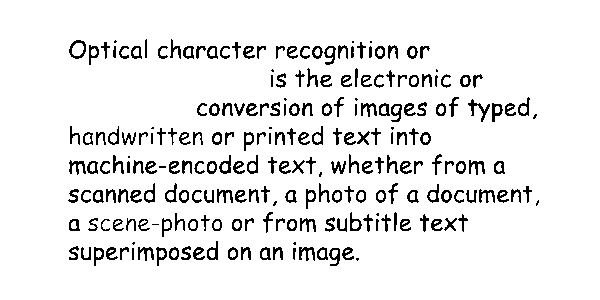
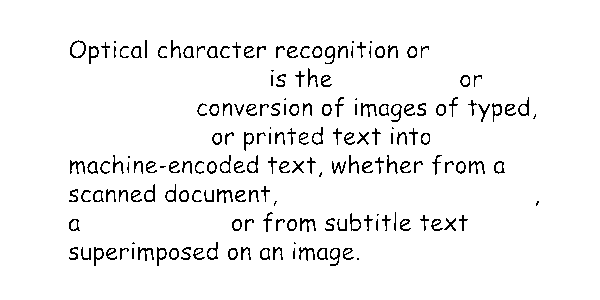
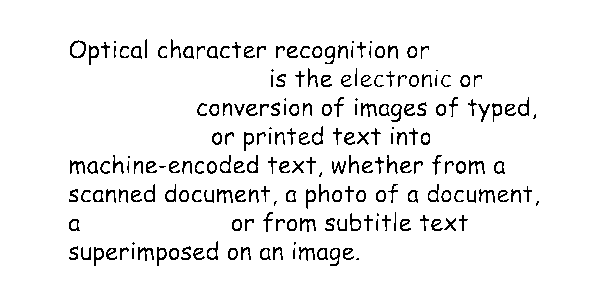
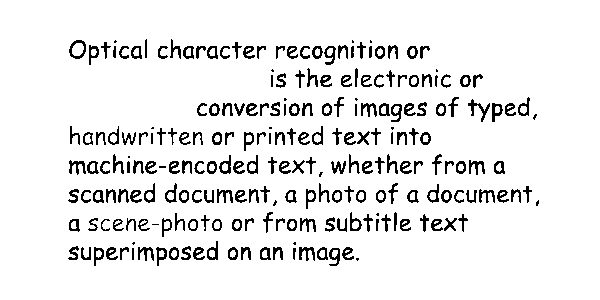
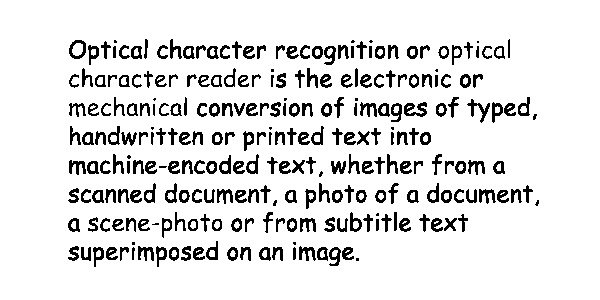
# Instantiate Aspose.OCR API
api = AsposeOcr()
# Initialize image processing
filters = PreprocessingFilter()
filters.add(PreprocessingFilter.threshold(0))
# Add image to the recognition batch and apply processing filter
input = OcrInput(InputType.SINGLE_IMAGE, filters)
input.add("source.png")
# Recognize the image
result = api.recognize(input)
# Print recognition result
print(result[0].recognition_text)
<specify threshold value to recognize the image>Optical character recognition or
is the electronic or
conversion of images of typed,
handwritten ore text into
machine-encoded text, whether from a
scanned document, a photo of a document,
a scene-photo or from subtitle text
superImposed on an image.
Optical character recognition or
Is the or
conversion of images of typed,
or printed text into
machine-encoded text, whether from a
scanned document,
a or from subtitle text
superimposed on an image.
Optical character recognition or
is the electronic or
conversion of images of typed,
or printed text into
machine-encoded text, whether from a
scanned document, a photo of a document,
a or from subtitle text
superimposed or an Image.
Optical character recognition or
is the electronic or
conversion of images of typed,
handwritten or printed text into
machine-encoded text, whether from a
scanned document,a photo of a document,
a scene-photo or from subtitle text
superimposed on an image.
Optical character recognition or optical
character reader is the electronic or
mechanical conversion of images of typed,
handwritten or printed text into
machine-encoded text, whether from a
scanned document,a photo of a document,
a scene-photo or from subtitle text
superimposed on an image.
Binarization is always used for text detection and automatic image corrections. Also, monochrome images take up significantly less disk space than full color images, so you can use binarization for archiving digitized documents.
Analyzing your prompt, please hold on...
An error occurred while retrieving the results. Please refresh the page and try again.